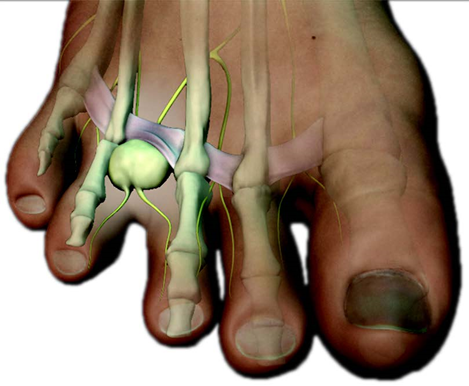Morton’s Neuroma
What is it?
A Morton’s Neuroma is a common foot problem consisting of a benign tumor-like enlargement of a nerve at the ball of the foot. It is usually located be-tween the third and fourth toes, occasionally between the second and third. This condition is not a true tumor but rather a thickening of the tissue around the nerve. Symptoms of a Morton’s Neuroma include sharp pain, burning sensation and even a lack of feeling in the area. It is usually worsened by walking and pressure on the ball of the foot. This is a soft tissue deformity and will not show up on x-ray. Diagnosis is made by eliciting pain in the area between the toes with pressure on the nerve. You may also notice that you can see an increased gap or space be-tween your third and fourth toes. Moving your toes in certain directions may also cause a clicking sensation as the enlarged nerve slides under a nearby ligaments.
 How did I get it?
How did I get it?
A neuroma is formed by irritation and rubbing of the nerve, similar to the way a callus is formed on your skin from excessive rubbing or pressure. The nerve “skin” gradually thickens to protect itself, forming a benign tumor. When the arch of your foot collapses, it causes excess force to shift away from the big toe and onto the smaller bones of your forefoot. These smaller bones are not designed to handle the loads, so the excess force tends to break down the tissues under them, including the nerves running between them to the toes. As the nerve thickens to protect itself, it occupies more space and is more easily rubbed. Eventually, the nerve gets so big that it is sensitive to every step and it can even spread the toes (called “the daylight sign” since you can see light between your toes, as pictured above).
Shoe wear that is too tight in the toe area, high heels that place additional pressure on your forefoot, and an increase in activity are also thought to exacerbate the pain of a Morton’s Neuroma.
How is it treated?
As with most foot problems there are two main concepts in the treatment of a Morton`s Neuroma: 1) reduce the symptoms, and 2) address the underlying cause.
Injections: Cortisone can be injected into the area to control inflammation and pain. This may be helpful in reducing the pain temporarily but does not address the cause of your symptoms. Overuse of injected steroids can result in side effects such as weight gain and increased blood pressure and can interfere with proper healing, which is why patients only receive a limited number of injections.
Surgery: In cases that do not respond to conservative measures, your doctor may recommend surgery. The surgery is thought to be very successful in reducing the pain of a Morton’s Neuroma but is a last resort as it comes with risks. The surgery involves the removal of both the tumor and some of your nerve. This often causes permanent numbness in the affected toes. The nerve will grow back slowly over time. If the underlying cause of the original problem is not treated, the nerve will become a “stump neuroma” which is often more painful than the first one.
Custom Foot Orthotics: The right custom made orthotics will address your pain by correcting the cause of your foot dysfunction. Sole Supports are uniquely designed to support and restore full arch function in your feet. This also restores proper weight distribution over the big toe and removes the abnormal pressures causing your nerve to thicken. The nerve can then heal and shrink back to normal size. It is important to note that, as with most conditions, attacking the problem early enough is critical to avoid the need for surgery. Should surgery eventually be necessary, though, use of Sole Supports immediately after surgery can help insure that the tumor does not come back.
What can I expect from treatment?
With a proper diagnosis, and a well-rounded treatment plan based on effective orthotics, the prognosis is excellent. Over 90% of cases will usually respond favorably to proper orthotic management if addressed early enough.


